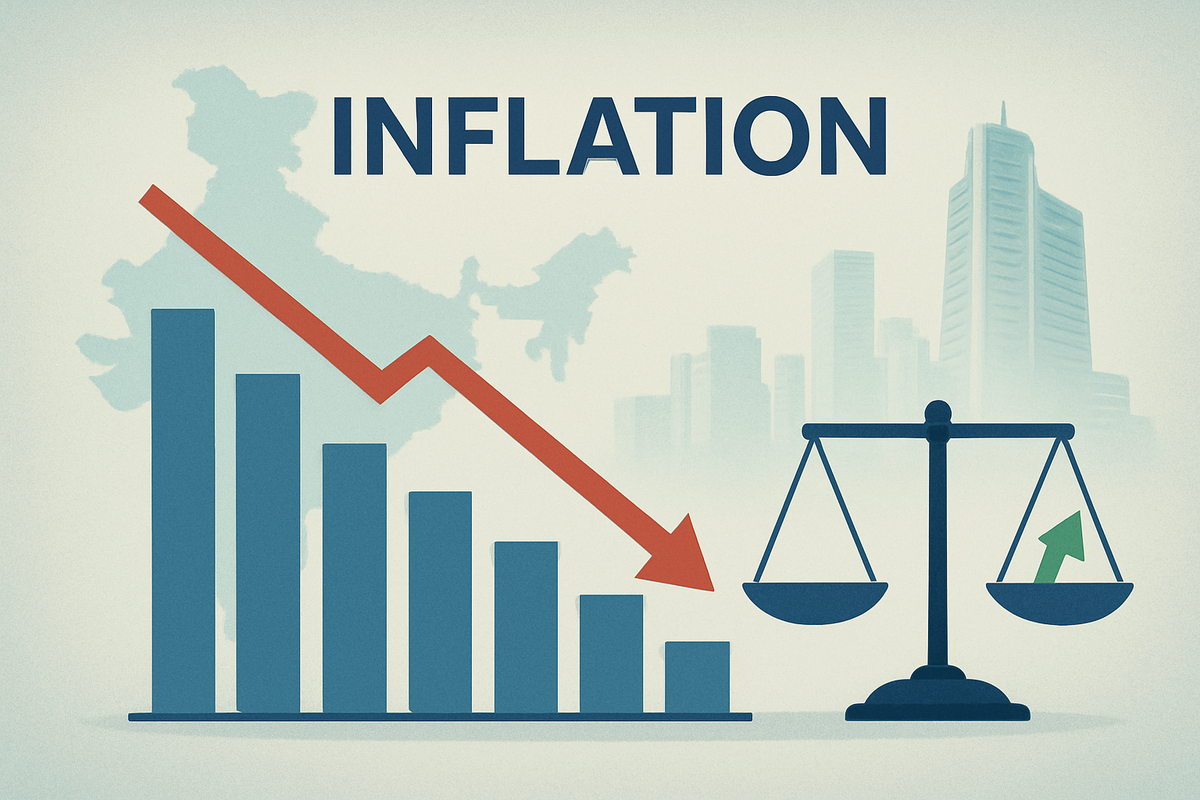
New Delhi, India – November 17, 2025 – India's wholesale inflation has reportedly bottomed out, with a significant report suggesting it is poised to remain in negative territory for much of the financial year 2025-26. This prolonged period of deflation in wholesale prices, driven by subdued global commodity prices, seasonal food price declines, and recent Goods and Services Tax (GST) rate rationalizations, presents a complex picture for the Indian economy. While offering relief from input cost pressures for some sectors, it also raises concerns about manufacturers' pricing power and potential implications for nominal GDP growth, prompting close observation from policymakers and market participants alike.
The immediate implications of this trend are multifaceted. On one hand, the easing price pressures could provide the Reserve Bank of India (RBI) with greater room to maneuver its monetary policy, potentially leading to interest rate cuts aimed at stimulating economic activity. On the other hand, a sustained negative WPI could signal sluggish demand, forcing manufacturers to offer discounts and potentially squeezing profit margins across various industries. The delicate balance between fostering growth and managing inflationary expectations will be a key challenge for economic strategists in the coming months.
Decoding the Deflation: A Deep Dive into India's Wholesale Price Trends
The latest data reveals a notable contraction in India's Wholesale Price Index (WPI), which registered a significant decline to -1.21% in October 2025. This marks a considerable drop from the 0.13% recorded in September and represents the steepest fall in wholesale prices since July 2023. The primary drivers behind this contraction were sharp decreases in the prices of critical components such as food articles, crude petroleum, natural gas, electricity, mineral oils, and basic metals, collectively painting a picture of broad-based price moderation at the wholesale level.
Breaking down the figures, food article prices experienced a substantial deflation of -8.31% in October, a stark contrast to -5.04% in September. This was particularly pronounced in vegetables, pulses, potatoes, and onions, which saw dramatic price reductions. The Fuel & Power group also continued its downward trend, registering negative inflation at -2.55% annually, extending a seven-month streak of deflation. Even the Manufactured Products category, which accounts for nearly two-thirds of the WPI basket, saw its inflation moderate to 1.54% in October from 2.33% in September, reinforcing the pervasive nature of the wholesale price slowdown.
According to a report by Union Bank of India, while wholesale inflation has "bottomed out," it is expected to gain only slight momentum from November onwards and is projected to remain in negative territory for a significant portion of the remaining months of the financial year 2025-26. The bank's 2025-26 WPI forecast currently tracks below 0.35%, attributing this subdued outlook to persistently low global commodity prices and the anticipated seasonal decline in food prices. The Reserve Bank of India (RBI) has also revised its retail inflation (Consumer Price Index - CPI) outlook for 2025-26 downwards to 3.7% from an earlier forecast of 4%, with its Monetary Policy Committee (MPC) projecting headline inflation for the full year FY26 at an even lower 2.6%. This comprehensive easing of price pressures across both wholesale and retail segments suggests a robust environment for price stability in the near to medium term.
Corporate Winners and Losers in a Deflationary Landscape
The sustained period of negative wholesale inflation in India is set to create a distinct dichotomy among public companies, fostering both beneficiaries and those facing significant headwinds. Companies heavily reliant on raw material inputs are poised to be the primary winners. Lower input costs for commodities such as crude petroleum, basic metals, and various food articles will directly translate into reduced operational expenses, thereby bolstering profit margins. For instance, manufacturing firms in sectors like Fast-Moving Consumer Goods (FMCG) – such as Hindustan Unilever (NSE: HINDUNILVR) or Nestle India (NSE: NESTLEIND) – and automobile manufacturers like Tata Motors (NSE: TATAMOTORS) or Maruti Suzuki India (NSE: MARUTI), could see improved profitability as their input costs decline while consumer demand remains stable or grows. Export-oriented industries, in particular, could gain a competitive edge in international markets due to lower production costs, making their products more attractive globally.
Conversely, sectors and companies with limited pricing power or those that thrive on inflationary environments may face significant challenges. Retailers, for example, might experience squeezed profit margins if consumers delay purchases in anticipation of further price drops, or if they are unable to pass on higher operating costs due to competitive pressures from falling wholesale prices. This could impact large retail chains like Reliance Retail (NSE: RELIANCE) or Avenue Supermarts (DMart) (NSE: DMART). The banking sector could also face headwinds; while lower interest rates might stimulate credit demand, a prolonged period of low inflation and potential rate cuts by the RBI could lead to compressed Net Interest Margins (NIMs) for lenders like State Bank of India (NSE: SBIN) or HDFC Bank (NSE: HDFCBANK), affecting their overall profitability. Furthermore, producers of raw materials might see their revenues and margins shrink as the prices of their outputs remain subdued.
The dynamic of negative WPI also puts pressure on manufacturers to innovate and differentiate their products beyond price. Companies that can leverage lower input costs to invest in research and development, improve product quality, or expand their market reach are likely to navigate this environment more successfully. Those unable to adapt quickly to the shifting pricing landscape, or those with high fixed costs and limited flexibility in their pricing strategies, may find themselves struggling to maintain profitability and market share. The coming quarters will test the resilience and adaptability of corporate India in an environment where cost efficiency and strategic positioning will be paramount.
Broader Economic Ripple Effects and Policy Implications
The persistent negative wholesale inflation outlook for India through 2025-26 carries significant broader economic implications, extending beyond immediate corporate balance sheets. This trend fits into a larger global narrative of easing commodity prices, reflecting a combination of stabilized supply chains post-pandemic disruptions and potentially moderated global demand. For India, a large net importer of commodities, particularly crude oil, this translates into a substantial reduction in its import bill, positively impacting the nation's current account deficit and strengthening the rupee. This also provides a crucial buffer against external economic shocks, bolstering macroeconomic stability.
From a policy perspective, the subdued inflation environment offers the Reserve Bank of India (RBI) considerable flexibility in its monetary policy stance. With both wholesale and retail inflation projections running below earlier estimates, there is an increased likelihood of a potential 25 basis points repo rate cut in the RBI's upcoming December monetary policy review meeting. Such a move would aim to stimulate economic growth by making borrowing cheaper for businesses and consumers, thereby encouraging investment and consumption. However, the RBI will also need to carefully balance the need for growth stimulus against the risk of creating asset bubbles or fueling future inflationary pressures once the current disinflationary forces wane.
Historically, periods of sustained low or negative wholesale inflation have often preceded or coincided with economic slowdowns if not managed carefully. While India's real GDP growth momentum remains robust, the subdued WPI and CPI projections are expected to put pressure on nominal GDP growth. This could have implications for government revenue collection, as tax collections are often tied to nominal economic activity. Furthermore, this trend could create ripple effects on competitors and partners within the supply chain, potentially leading to a cascading effect of price adjustments. Regulatory bodies might also scrutinize pricing practices to ensure fair competition, particularly if manufacturers are perceived to be unduly withholding price benefits from end-consumers despite lower input costs.
Navigating the Future: Opportunities and Challenges Ahead
Looking ahead, the sustained period of negative wholesale inflation presents a mixed bag of short-term and long-term possibilities for the Indian economy and its markets. In the short term, the most anticipated outcome is a potential easing of monetary policy by the Reserve Bank of India (RBI). A repo rate cut, possibly as early as the December monetary policy review, would reduce borrowing costs, providing a much-needed impetus to credit growth and investment. This could particularly benefit interest-rate sensitive sectors such as real estate, automotive, and capital goods, potentially spurring a modest uptick in demand. Consumers might also see a slight boost in purchasing power as the benefits of lower wholesale prices gradually trickle down to retail.
However, the long-term implications require careful consideration. While lower input costs are beneficial, a prolonged period of negative WPI could indicate underlying weaknesses in demand, leading to reduced investment in capacity expansion by manufacturers. This could stifle future job creation and economic growth. Companies will need to strategically pivot, focusing on cost efficiencies, supply chain optimization, and product innovation to maintain profitability in an environment where pricing power is constrained. Market opportunities may emerge for businesses that can effectively leverage lower input costs to offer more competitive products or expand into new markets. Conversely, challenges will persist for those reliant on price increases for revenue growth or those with high fixed costs that become harder to cover in a deflationary environment.
Potential scenarios and outcomes could range from a "soft landing" where the RBI successfully stimulates growth without reigniting inflation, to a more challenging environment where deflationary pressures persist longer than expected, impacting corporate earnings and overall economic vibrancy. The government's fiscal policy will play a crucial role in complementing monetary measures, with targeted spending or tax incentives potentially cushioning any adverse effects on demand. Investors will need to closely monitor global commodity price movements, the RBI's policy pronouncements, and corporate earnings reports to gauge the true impact of this unique inflationary landscape.
Concluding Thoughts: A New Era of Price Stability and Strategic Adaptation
The anticipated prolonged period of negative wholesale inflation through 2025-26 marks a significant turning point for the Indian economy, ushering in an era characterized by enhanced price stability at the wholesale level. The key takeaway from this event is the substantial relief it offers from input cost pressures for a broad spectrum of industries, potentially boosting corporate profitability and fostering a more competitive manufacturing landscape. However, this stability comes with the nuanced challenge of navigating potentially subdued demand and the imperative for companies to adapt their pricing and operational strategies.
Moving forward, the market will be keenly assessing the Reserve Bank of India's (RBI) response, particularly the likelihood and timing of interest rate adjustments. A well-calibrated monetary policy, coupled with supportive fiscal measures, will be crucial in leveraging the benefits of lower inflation to spur economic growth without creating future imbalances. The lasting impact of this period of disinflation could reshape industry structures, rewarding agile businesses that prioritize efficiency, innovation, and strategic market positioning over sheer pricing power.
Investors should closely watch several key indicators in the coming months: the trajectory of global commodity prices, particularly crude oil; the RBI's monetary policy decisions and their forward guidance; and critically, the earnings reports of public companies across various sectors, especially those in manufacturing, banking, and retail. These reports will provide real-time insights into how businesses are adapting to the prevailing deflationary environment and whether the benefits of lower input costs are translating into sustainable profit growth or merely offsetting demand-side challenges. This period, while presenting its own set of complexities, ultimately offers an opportunity for India to consolidate its macroeconomic stability and lay the groundwork for sustained, non-inflationary growth.
This content is intended for informational purposes only and is not financial advice





